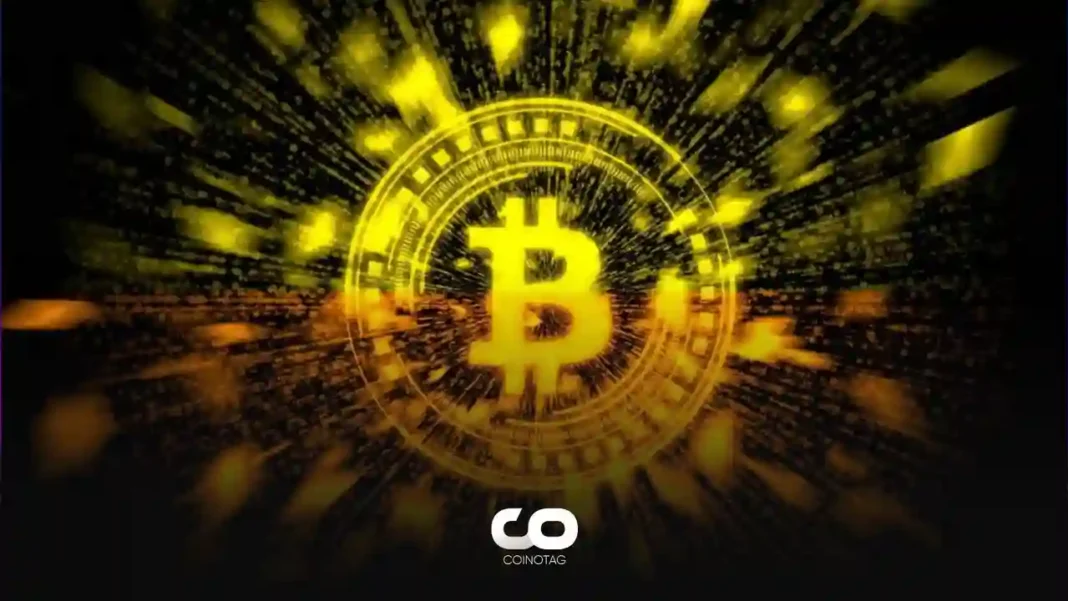| COINOTAG recommends • Exchange signup |
| 💹 Trade with pro tools |
| Fast execution, robust charts, clean risk controls. |
| 👉 Open account → |
| COINOTAG recommends • Exchange signup |
| 🚀 Smooth orders, clear control |
| Advanced order types and market depth in one view. |
| 👉 Create account → |
| COINOTAG recommends • Exchange signup |
| 📈 Clarity in volatile markets |
| Plan entries & exits, manage positions with discipline. |
| 👉 Sign up → |
| COINOTAG recommends • Exchange signup |
| ⚡ Speed, depth, reliability |
| Execute confidently when timing matters. |
| 👉 Open account → |
| COINOTAG recommends • Exchange signup |
| 🧭 A focused workflow for traders |
| Alerts, watchlists, and a repeatable process. |
| 👉 Get started → |
| COINOTAG recommends • Exchange signup |
| ✅ Data‑driven decisions |
| Focus on process—not noise. |
| 👉 Sign up → |
- In a stunning turnaround from the shadow of the 2022 decline, Bitcoin has seen a remarkable 160% increase in value this year, contributing over $530 billion to its market capitalization.
- According to Bloomberg’s latest report, Michael Saylor, the co-founder of MicroStrategy Inc., sees this approval as a “significant catalyst.”
- Consumer Price Index (CPI) and Producer Price Index (PPI) reports also indicated a easing of inflation in the U.S., increasing bets on Fed policy interest rate cuts in 2024.
As the end of 2023 approaches, COINOTAG examined the reasons behind the massive rise in BTC price: Here are the details!
Bitcoin Experienced a Massive Increase in 2023

In a stunning turnaround from the shadow of the 2022 decline, Bitcoin has seen a remarkable 160% increase in value this year, contributing over $530 billion to its market capitalization. This unexpected rally not only revitalized the leading cryptocurrency but also reignited interest in the overall crypto market.
Significantly, this year has been a bullish one not only for Bitcoin but also for the entire crypto market, as more institutional investors showed interest in the market. Therefore, let’s take a look at the key events driving the rally in Bitcoin’s price and the overall market.
| COINOTAG recommends • Professional traders group |
| 💎 Join a professional trading community |
| Work with senior traders, research‑backed setups, and risk‑first frameworks. |
| 👉 Join the group → |
| COINOTAG recommends • Professional traders group |
| 📊 Transparent performance, real process |
| Spot strategies with documented months of triple‑digit runs during strong trends; futures plans use defined R:R and sizing. |
| 👉 Get access → |
| COINOTAG recommends • Professional traders group |
| 🧭 Research → Plan → Execute |
| Daily levels, watchlists, and post‑trade reviews to build consistency. |
| 👉 Join now → |
| COINOTAG recommends • Professional traders group |
| 🛡️ Risk comes first |
| Sizing methods, invalidation rules, and R‑multiples baked into every plan. |
| 👉 Start today → |
| COINOTAG recommends • Professional traders group |
| 🧠 Learn the “why” behind each trade |
| Live breakdowns, playbooks, and framework‑first education. |
| 👉 Join the group → |
| COINOTAG recommends • Professional traders group |
| 🚀 Insider • APEX • INNER CIRCLE |
| Choose the depth you need—tools, coaching, and member rooms. |
| 👉 Explore tiers → |
Amid ongoing skepticism and regulatory challenges, the cryptocurrency market experienced an extraordinary revival driven by optimism surrounding the potential approval of a Bitcoin Spot ETF by U.S. regulators. According to Bloomberg’s latest report, Michael Saylor, the co-founder of MicroStrategy Inc., sees this approval as a “significant catalyst” and believes it will pave the way for a new avenue for mainstream investors.
In his statement, Saylor emphasizes the importance of the approval of spot ETFs for Bitcoin, stating that it could act as a significant catalyst, creating a substantial increase in demand. Saylor’s optimism is based on the belief that the primary reason for the existing limitations is the lack of a robust and compatible investment channel for Bitcoin, especially one with high bandwidth.
| COINOTAG recommends • Exchange signup |
| 📈 Clear interface, precise orders |
| Sharp entries & exits with actionable alerts. |
| 👉 Create free account → |
| COINOTAG recommends • Exchange signup |
| 🧠 Smarter tools. Better decisions. |
| Depth analytics and risk features in one view. |
| 👉 Sign up → |
| COINOTAG recommends • Exchange signup |
| 🎯 Take control of entries & exits |
| Set alerts, define stops, execute consistently. |
| 👉 Open account → |
| COINOTAG recommends • Exchange signup |
| 🛠️ From idea to execution |
| Turn setups into plans with practical order types. |
| 👉 Join now → |
| COINOTAG recommends • Exchange signup |
| 📋 Trade your plan |
| Watchlists and routing that support focus. |
| 👉 Get started → |
| COINOTAG recommends • Exchange signup |
| 📊 Precision without the noise |
| Data‑first workflows for active traders. |
| 👉 Sign up → |
Therefore, there is an expectation that the approval of spot ETFs will fill this void and potentially lead to an increase in demand for cryptocurrencies. Additionally, speculation about the Bitcoin halving event in 2024 has also heightened investor sensitivity.
Furthermore, the Federal Reserve’s dovish stance and the decline in inflation this year have created positive sentiment in the market. The latest report from the U.S. Department of Commerce revealed a 0.1% monthly increase and a 3.2% annual increase in the core PCE price index (excluding volatile food and energy prices). Meanwhile, PCE inflation showed a 1.9% increase on a six-month basis, indicating that the Federal Reserve is approaching its inflation target if current trends continue.
| COINOTAG recommends • Traders club |
| ⚡ Futures with discipline |
| Defined R:R, pre‑set invalidation, execution checklists. |
| 👉 Join the club → |
| COINOTAG recommends • Traders club |
| 🎯 Spot strategies that compound |
| Momentum & accumulation frameworks managed with clear risk. |
| 👉 Get access → |
| COINOTAG recommends • Traders club |
| 🏛️ APEX tier for serious traders |
| Deep dives, analyst Q&A, and accountability sprints. |
| 👉 Explore APEX → |
| COINOTAG recommends • Traders club |
| 📈 Real‑time market structure |
| Key levels, liquidity zones, and actionable context. |
| 👉 Join now → |
| COINOTAG recommends • Traders club |
| 🔔 Smart alerts, not noise |
| Context‑rich notifications tied to plans and risk—never hype. |
| 👉 Get access → |
| COINOTAG recommends • Traders club |
| 🤝 Peer review & coaching |
| Hands‑on feedback that sharpens execution and risk control. |
| 👉 Join the club → |
On the other hand, previous Consumer Price Index (CPI) and Producer Price Index (PPI) reports also indicated a easing of inflation in the U.S., increasing bets on Fed policy interest rate cuts in 2024.
Challenges Continue for BTC
The Bitcoin price registered a slight 0.24% decline in the last 24 hours and traded at $43,606.06 at the time of writing, with a 28.92% decrease in trading volume, falling to $17.38 billion. However, the crypto has added over 16% on a monthly basis and has shown a nearly 160% increase since the beginning of the year. Bitcoin’s market capitalization has also increased by over $500 billion throughout the year.
Despite ongoing success, the crypto market faces challenges. Events like the $4.3 billion fine imposed on Binance and legal issues experienced by industry figures like Sam Bankman-Fried have left lasting marks. Market depth, a measure of the ability to process large orders without a significant price impact, has also experienced a decline, posing a barrier to smooth trading.
However, Bitcoin derivatives saw increased activity in 2023, with both options and futures markets reaching record levels of open positions. This growing interest is reflected in the decentralized finance sector, where liquidity gain protocols have reached new highs, providing easier access to blockchain rewards.
| COINOTAG recommends • Exchange signup |
| 📈 Clear control for futures |
| Sizing, stops, and scenario planning tools. |
| 👉 Open futures account → |
| COINOTAG recommends • Exchange signup |
| 🧩 Structure your futures trades |
| Define entries & exits with advanced orders. |
| 👉 Sign up → |
| COINOTAG recommends • Exchange signup |
| 🛡️ Control volatility |
| Automate alerts and manage positions with discipline. |
| 👉 Get started → |
| COINOTAG recommends • Exchange signup |
| ⚙️ Execution you can rely on |
| Fast routing and meaningful depth insights. |
| 👉 Create account → |
| COINOTAG recommends • Exchange signup |
| 📒 Plan. Execute. Review. |
| Frameworks for consistent decision‑making. |
| 👉 Join now → |
| COINOTAG recommends • Exchange signup |
| 🧩 Choose clarity over complexity |
| Actionable, pro‑grade tools—no fluff. |
| 👉 Open account → |
| COINOTAG recommends • Members‑only research |
| 📌 Curated setups, clearly explained |
| Entry, invalidation, targets, and R:R defined before execution. |
| 👉 Get access → |
| COINOTAG recommends • Members‑only research |
| 🧠 Data‑led decision making |
| Technical + flow + context synthesized into actionable plans. |
| 👉 Join now → |
| COINOTAG recommends • Members‑only research |
| 🧱 Consistency over hype |
| Repeatable rules, realistic expectations, and a calmer mindset. |
| 👉 Get access → |
| COINOTAG recommends • Members‑only research |
| 🕒 Patience is an edge |
| Wait for confirmation and manage risk with checklists. |
| 👉 Join now → |
| COINOTAG recommends • Members‑only research |
| 💼 Professional mentorship |
| Guidance from seasoned traders and structured feedback loops. |
| 👉 Get access → |
| COINOTAG recommends • Members‑only research |
| 🧮 Track • Review • Improve |
| Documented PnL tracking and post‑mortems to accelerate learning. |
| 👉 Join now → |








